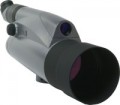The location of the eyepiece relative to the body (more precisely, relative to the optical axis) of the tube.
—
Direct. In this case, the eyepiece is directed parallel to the optical axis of the tube — in other words, it "looks" in the same direction as the lens. In this case, the eyepiece can be directly on the optical axis or above it. The direct arrangement is convenient especially in those cases when the tube is used without a tripod and is held in the hands. It is well suited for observations from a shelter (for example, during hunting or wildlife research) — the observer does not need to rise above the body of the tube to look into the eyepiece. Also, this option is easier for novice users who have not previously dealt with optical instruments — it is more convenient to point the pipe at the target. In addition, when the eyepiece is located on the same axis as the lens, prisms can be dispensed with, which simplifies the design (although this arrangement in itself does not mean the absence of prisms).
—
Under 45°. An eyepiece bent upwards by 45° relative to the optical axis of the tube. In many situations, this arrangement is more convenient for the observer. For example, it allows you to comfortably use a relatively low tripod (whereas a tube with a straight eyepiece must be placed at eye level, that is, either look for a high tripod or squat to the level of the eyepiece). In add
...ition, for similar reasons, curved eyepieces are more convenient when observing objects above the horizon and celestial bodies. The disadvantage of this design is the unequivocal need to use Porro prisms (see "Prism type"), which can affect the cost. In addition, for a person without experience, aiming a curved pipe at the desired object can, out of habit, be quite a difficult task.
